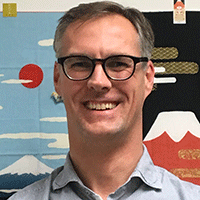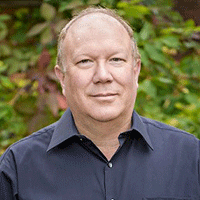
Prof. Jia-Yang Juang
Professor and Associate Chair of the Department of Mechanical Engineering, National Taiwan University
Lecture Title: Soft Robotics: Shape Morphing and Locomotion by Controlled Buckling
Abstract: Conventional “hard” robots, constructed largely of metal or hard plastic elements, are widely used in manufacturing and can perform pre-programed operations accurately and precisely, but often with limited adaptability and limited capability of handling fragile objects. By contrast, soft robots are primarily composed of softoften elastomericmaterials, and can deform in a continuous way to achieve high adaptability. A unique feature of highly elastic elastomer is that it can undergo repeated buckling without much permanent deformation, which makes it possible of utilizing buckling for robot locomotion. Buckling, a phenomenon of mechanical instability, is traditionally considered as a mode of failures, which results in a sudden and significant change in the shape of slender structures, e.g., beams, plates, and shells. However, there is a burgeoning trend, referred to as Buckliphilia, that envisions mechanical instabilities as opportunities for new functionalities and applications. In this talk, I summarize some studies conducted in the Multiscale Systems Laboratory (MSL) at National Taiwan University on using controlled buckling as a means for shape morphing and soft robots: (1) Forming three-dimensional closed shapes from two-dimensional soft ribbons by controlled buckling; (2) tube-crawling soft robots driven by multistable buckling mechanics; (3) soft hopping and crawling robot for in-pipe traveling; (4) single-actuator soft robot for in-pipe traveling; (5) vacuum-actuated buckling-based fingers.
Biography: Professor Jia-Yang Juang received the B.S. and M.S. degrees from National Taiwan University in 1997 and 1999, respectively, and the Ph.D. degree from University of California, Berkeley in 2006, all in Mechanical Engineering. His PhD study was funded by Computer Mechanics Laboratory (CML) and California State Nanotechnology Fellowship. From 2006 to 2011 he worked as a Research Staff Member and Senior Principal Engineer in Hitachi Global Storage Technologies and Western Digital Corp., respectively, in Silicon Valley, California. He joined the faculty of Department of Mechanical Engineering at National Taiwan University in 2011, and is now a full professor and associate chair. He is a Senior Member of IEEE and a Member of ASME.
Prof. Juang's research interests include thin film materials/atmospheric pressure plasma jet/laser processing, mechanics of biological materials/ bioinspired materials, and soft robotics/ shape morphing. He holds 16 granted United States patents, one China patent and several pending United States patents. He has published 40 journal papers and 40 papers in international conference proceedings. He is on the editorial board of three journals, and has reviewed manuscripts for 49 journals. He won the Best Paper Award in the 28th and 29th ASME Annual Conferences on Information Storage and Processing Systems (ISPS 2019 and 2020).

Kris Schouterden, Ph.D.
Vice President, Development Engineering, HDD R&D, Western Digital
Lecture Title: HDD2030 - The Passion for Innovation and Invention Continues
Abstract: The HDD industry has been the subject of predictions of demise ever since the discovery of the super-paramagnetic effect in 1977. Now, 44 years later, this same device is not only thriving, it is enabling the next "industrial revolution": applications based on Machine Learning and Artificial Intelligence are only possible because of all the data that can be warehoused by the HDDs we continue to develop. The central theme that enables this continued support of the society by HDD, is Innovation and Invention. We will discuss how HDD is yet-again re-inventing itself and innovating in new aspects of the device. Aside from the technology development to support the foundational capacity growth per disk going forward, we will introduce different aspects where innovation is required. These innovations are driven by the sheer EB-growth we will see in the next decade. They also will come from the necessity to support different storage tiers for Datacenters to handle cooler and warmer data. And they will result from the desire to push compute upstream towards the data to reduce network traffic. The shape of HDD remains the same as it always has been: ever morphing.
Biography: After graduate school, Kris joined IBM in 1997 as an engineer doing development in the area of advanced head-disk-interface. His first contact with product development came in 2001 during a 1-year assignment in Fujisawa working on mobile products. After returning to San Jose, Kris took progressively broader roles in the Performance Enterprise development area and subsequently started to cover all HDD products. After another international assignment to Fujisawa between 2011-2014, currently, he is VP of Recording Sub-System product development.

John W. Dykes, Ph.D.
Managing Principal Technologist at Seagate Technology
Lecture Title: Meeting Datasphere Storage Needs Through HDD Engineering
Abstract: Driven by a massive explosion in data creation, the world's data will exceed 175 ZB by 2025. According to Seagate's Rethink Data report, enterprise data will grow next year at an average growth rate of 42%. To keep up with storage demands, IDC predicts that over 22 ZB of storage capacity will have to ship across all media types from 2018 to 2025. Hard disk drives (HDDs) will continue to store the vast majority of that new content. Critical components of this key data storage device include the heads and media of the recording system along with the mechanical and servo systems. To achieve the desired capacity growth, aspects of these components will need to reduce to the atomic scale. At the same time, systems containing HDDs will need to be designed to minimize harmful disturbances. With these component scaling and system environmental enhancements, HDDs will deliver at least another decade of exponential capacity growth.
Biography: John Dykes is a Managing Principal Technologist with responsibility for Device Physics simulation, experiments and staging in the research division of Seagate Technology. He holds a B.S. degree in Physics from Utah State University along with M.S. and Ph.D. degrees in experimental solid state physics from the University of California-Davis. During his career, John has conducted fundamental research at Lawrence Livermore National Laboratory and the National Institute of Standards and Technology. He has held engineering and management positions at several data storage companies over the past 24 years. John's areas of expertise include device physics and manufacturing, process development, technology assessment and staging, systems engineering, experimental design and data analysis, metrology and product development. He holds 11 patents and has been inducted into the Seagate Inventor's Hall of Fame.